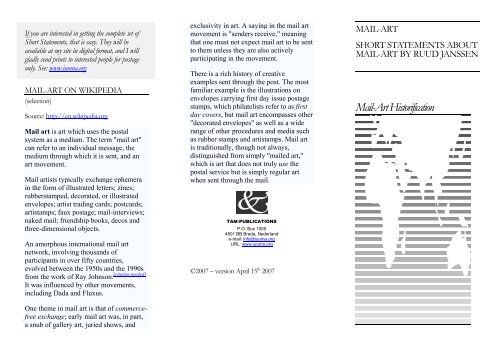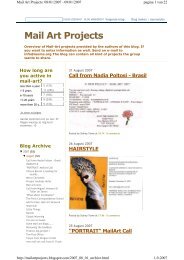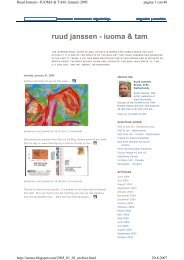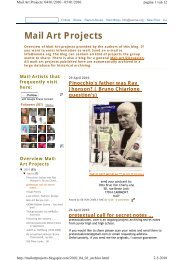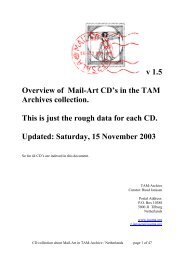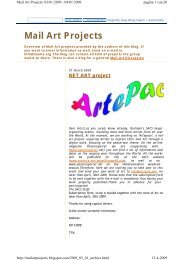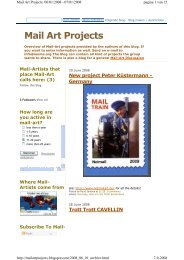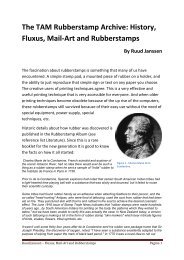Folder about Mail-Art Historification - Ruud Janssen
Folder about Mail-Art Historification - Ruud Janssen
Folder about Mail-Art Historification - Ruud Janssen
You also want an ePaper? Increase the reach of your titles
YUMPU automatically turns print PDFs into web optimized ePapers that Google loves.
If you are interested in getting the complete set of<br />
Short Statements, that is easy. They will be<br />
available at my site in digital format, and I will<br />
gladly send prints to interested people for postage<br />
only. See: www.iuoma.org<br />
MAIL-ART ON WIKIPEDIA<br />
(selection)<br />
Source: http://en.wikipedia.org<br />
<strong>Mail</strong> art is art which uses the postal<br />
system as a medium. The term "mail art"<br />
can refer to an individual message, the<br />
medium through which it is sent, and an<br />
art movement.<br />
<strong>Mail</strong> artists typically exchange ephemera<br />
in the form of illustrated letters; zines;<br />
rubberstamped, decorated, or illustrated<br />
envelopes; artist trading cards; postcards;<br />
artistamps; faux postage; mail-interviews;<br />
naked mail; friendship books, decos and<br />
three-dimensional objects.<br />
An amorphous international mail art<br />
network, involving thousands of<br />
participants in over fifty countries,<br />
evolved between the 1950s and the 1990s<br />
[citation needed]<br />
from the work of Ray Johnson.<br />
It was influenced by other movements,<br />
including Dada and Fluxus.<br />
One theme in mail art is that of commercefree<br />
exchange; early mail art was, in part,<br />
a snub of gallery art, juried shows, and<br />
exclusivity in art. A saying in the mail art<br />
movement is "senders receive," meaning<br />
that one must not expect mail art to be sent<br />
to them unless they are also actively<br />
participating in the movement.<br />
There is a rich history of creative<br />
examples sent through the post. The most<br />
familiar example is the illustrations on<br />
envelopes carrying first day issue postage<br />
stamps, which philatelists refer to as first<br />
day covers, but mail art encompasses other<br />
"decorated envelopes" as well as a wide<br />
range of other procedures and media such<br />
as rubber stamps and artistamps. <strong>Mail</strong> art<br />
is traditionally, though not always,<br />
distinguished from simply "mailed art,"<br />
which is art that does not truly use the<br />
postal service but is simply regular art<br />
when sent through the mail.<br />
<br />
TAM-PUBLICATIONS<br />
P.O. Box 1055<br />
4801 BB Breda, Nederland<br />
e-mail: info@iuoma.org<br />
URL: www.iuoma.org<br />
©2007 – version April 15 th 2007<br />
MAIL-ART<br />
SHORT STATEMENTS ABOUT<br />
MAIL-ART BY RUUD JANSSEN<br />
<strong>Mail</strong>-<strong>Art</strong> <strong>Historification</strong>
MAIL-ART<br />
HISTORIFICATION<br />
When you have this brochure in your hands<br />
you belong probably to the category of people<br />
who know what mail-art is. But do you really<br />
know what it is? After being working in the<br />
field for 27 years I still don’t……<br />
INTRODUCTION<br />
There are many ways to start with mail-art.<br />
Probably doing mail-art is the only way to get<br />
an idea of what it is all <strong>about</strong>.. Just reading<br />
<strong>about</strong> it always gives a false impression.<br />
SOURCES TO LEARN MORE<br />
When you have discovered mail-art in the past<br />
and have contacted lots of mail-artists you will<br />
have an idea of how things work and how<br />
people see mail-art. Online there are nowadays<br />
lots of publications. Books on mail-art? Yes,<br />
there are plenty, but you won’t find them in<br />
any bookshop. Only active mail-artists have a<br />
large collection. They tend to write themselves<br />
to explain what they have done and what they<br />
have encountered and get the information<br />
from their own network. If you are lucky the<br />
author has made things digital and you can get<br />
the information the easy way. Best sources<br />
<strong>about</strong> what happened since Ray Johnson<br />
started this concept are probably not online<br />
yet…..<br />
Just a First FOLDER for you to read. I plan to<br />
publish several more in the coming year. Feel free to<br />
copy or distribute, but mention source and don’t<br />
alter the text.<br />
DEFINING MAIL-ART<br />
Being a mail-artist since 1980 doesn’t give me<br />
the right to make my own definition. I know<br />
there are many ways to describe <strong>Mail</strong>-<strong>Art</strong>. The<br />
best definition probably can be found on the<br />
Internet. I used some fragments of what I<br />
found in wikipedia on the other side. This text<br />
has been edited by several persons over the<br />
years. What most probably don’ t know is that<br />
I once started this section of wikipedia years<br />
ago, but it isn’t my text anymore.<br />
Others made definitions too that are worth<br />
considering. Specially in the Thesis’s that were<br />
written on the subject (e.g. Honoria, Michael<br />
Lumb) but always by people inside the mail-art<br />
network. Once I read a definition in an art<br />
encyclopaedia, but I then found out it was<br />
written by Guy Bleus in Wellen, Belgium.<br />
THE RULES IN MAIL-ART<br />
If you expect here to find the ‘unwritten rules’ in<br />
mail-art I have to disappoint you. There are rules,<br />
but also different interpretations. Some tend to<br />
write the rules down, but that is only confusing.<br />
In different networks there are different rules. No<br />
selection or selection of the works. It all happens.<br />
The purists in mail-art have their golden rules, but<br />
following these rules isn’t always easy. That some<br />
unwritten rules are important is obvious. I once<br />
told in an interview that I consider some things I<br />
get garbage, and throw them away. PLG from<br />
Germany reacted strongly and as a concept<br />
ordered me to define all he sent as garbage and<br />
throw it away (or send it to other archives). Is<br />
there a rule I should keep all the mail-art I get in?<br />
Is everything mail-art? Is mail-art ‘guilt-free’ ?. Is<br />
there no censorship in a mail-art project allowed?<br />
Just a sample of some rules. But we all know.<br />
When you formalize rules, they will be broken. Is<br />
mail-art an art form without specific rules?<br />
PAST<br />
The ‘problem’ that exists is that current mailartists<br />
mostly try to describe the network after<br />
they have explored it (that includes me). Fact<br />
is that a newcomer might find a complete<br />
other mail-art network and therefore would<br />
describe it completely differently. Both stories<br />
are true. Stories written in the past therefore<br />
just explain the view of the network by one<br />
single person and only explains this one<br />
network of which the writer is the centre. If<br />
you know this person and you are part of his<br />
network, you tend to agree with the text. If<br />
not, you are in for some surprises. Actually<br />
that is on of the interesting aspects for me<br />
nowadays.<br />
FUTURE?<br />
This small text is <strong>about</strong> historification. By<br />
writing a text, others will use it and it might<br />
become a tool for this historification. The<br />
circle is made round again…<br />
© 2007 by TAM-PUBLICATIONS


